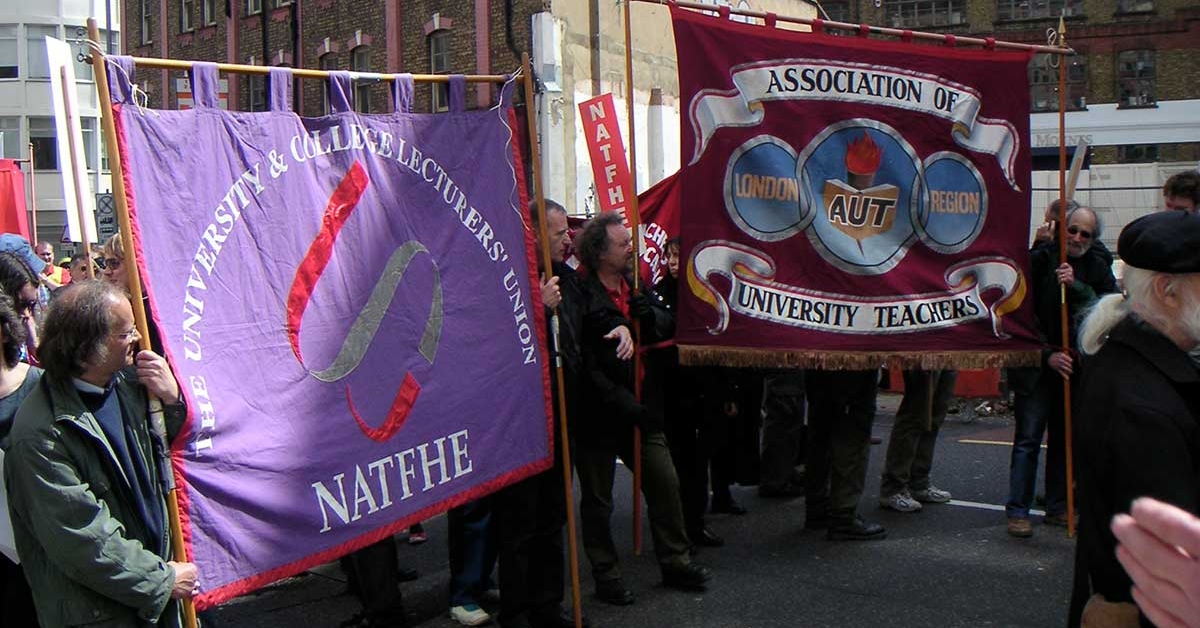
Our history
6 December 2006
The foundations of the two unions which merged to form UCU - the Association of University Teachers (AUT), and NATFHE-The University & College Lecturers' Union - were both laid in the first decade of the twentieth century.
In 1904, 200 technical teachers formed the London-based Association of Teachers in Technical Institutes (ATTI). Its influence soon spread outside London, with large branches forming in West Yorkshire, West Lancashire and East Lancashire.
Five years later, a group of lecturers at Liverpool University formed an association which, having built links with staff from other universities (including Bristol, Sheffield, Birmingham, Cardiff and Manchester), formed the core of the Association of University Lecturers, formally established at a conference of delegates from 15 institutions in 1917. This became the Association of University Teachers in 1919, when its membership was broadened to include professors.
Meanwhile, ATTI (which had quickly replaced 'Institutes' in its name with 'Institutions' in 1906) continued to grow and become more professional. In 1922 it appointed a full-time secretary, and in 1923 rented its first London office. The emergence of the Burnham salary system gave the association representation on national bodies. And ATTI steadily developed relations with other organisations; for example, by 1940 it had agreed a joint membership agreement with the National Union of Teachers.
Throughout the period up to the mid-1950s, AUT remained a relatively informal organisation. Oxford and Cambridge Universities joined in the 1930s, and the equivalent Scottish body - known as the Association of University Teachers (Scotland), set up in 1922 - joined in 1949. In 1955, the AUT achieved an important and long fought for victory by winning recognition as having a role in formal salary negotiation procedures. Shortly after, in 1959, the union appointed its first general secretary.
The 1960s and 1970s saw consolidation in FE as smaller colleges amalgamated, and the expansion of HE provision in the polytechnics: so much so that in 1965, ATTI's conference debated the question of adding HE to its name. Of even greater consequence, the 1966 conference voted for affiliation to the TUC, which duly took place on 1 January 1967, making ATTI the first teachers' body to join.
The enormous post-war expansion in education saw parallel growth in both AUT's and ATTI's memberships. Both grew from around 2,000 members in 1939 to 4,500 in 1951. The steady growth continued, and in 1972 ATTI was the fastest growing union in Britain, with around 40,000 members working throughout further education and the polytechnics. This included members in Northern Ireland, where the Northern Union of Technical Teachers in Ireland had come into ATTI in 1970.
Membership jumped again when ATTI merged with ATCDE (the Association of Teachers in Colleges and Departments of Education, formed in 1943 from an amalgamation of the 85-year-old Training College Association and the Council of Principals, formed in 1913), to form the National Association for Teachers in Further and Higher Education (NATFHE), which came into being on 1 January 1976.
Later that same year, NATFHE and AUT drew up a formal demarcation agreement, and the latter affiliated to the TUC, with AUT (Scotland) following in 1977. The close relationship between the two unions saw them working together in the Educational Alliance, formed with other unions in 1981 to fight government education cuts.
And the expansion in membership continued. AUT's membership had almost doubled from around 17,000 in 1969 to 33,000 in 1982, much of this growth due to the union's success in recruiting academic-related staff in universities. In 1983, the 25-year-old Association of Teachers in Penal Establishments voted to 'transfer engagements' into NATFHE. The following year, the Association for Adult and Continuing Education also agreed to come in, and the Association of Agricultural Education Staffs joined in 1990. Seven years later, AUT took into membership the 3,000-strong Association of University and College Lecturers, a post-1992 sector union.
The 1990s saw major developments for the shape of further and higher education - and for NATFHE and AUT. A government white paper in 1991 removed FE colleges from LEA control, and proposed to turn the polytechnics into the 'new' universities (this major development actually took place the following year, creating the 'post-92' sector). Throughout the 1990s and into the new millennium, the two unions increasingly worked together closely, and the question of merger was raised more than once. But it took until 2004 (coincidentally, NATFHE's centenary year) for both unions' policy-making conferences to finally vote to 'explore ways of achieving maximum unity between the two unions'.
Proposals for a new union which would include all AUT and NATFHE members quickly emerged and proposals to ballot members were endorsed at the unions' conferences in, respectively, April and May 2005. On 2 December 2005 the results of the ballots were announced, with merger being supported by 79.2% of AUT and 95.7% of NATFHE members who voted. The two unions amalgamated on 1 June 2006 to form UCU, with a combined membership of around 120,000.
- PrintPrint this page
- Share

